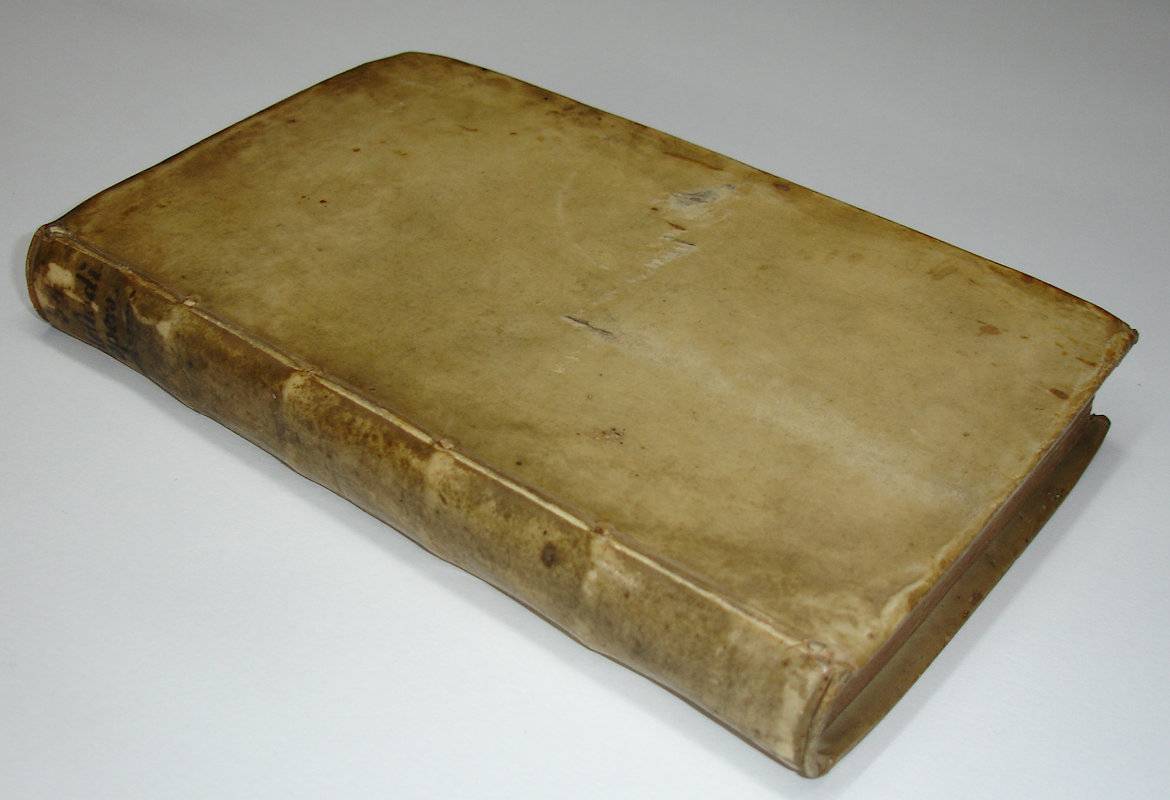HESIODUS.
HÊSIODOU ASKRAIOU ta heuriskomena. Hesiodi Ascraei quae extant. Daniel Heinsius interpretationem infinitis locis emendavit. Introductionem in Opera & Dies, in qua Hesiodi philosophia nunc primum exponitur, item notas, addidit.
Leiden (Lugduni Batavorum), Ex Officina Ioannis Patij, Iurati & Ordinarii Academiae Typographi, Prostant in Bibliopolio Commeliniano, 1613.
8vo. 2 parts in 1. (XXXVIII),(2 blank),1-204,(2, second title),205-312,(3),(3 blank) p. Vellum 18.5 cm (
Ref: STCN ppn 059312521; Hoffmann 2,249; Graesse 3,263; Ebert 9599) (
Details: 6 thongs laced through both joints. First title in red and black. Woodcut printer's mark on the title, it depicts Pallas Athena standing in an archway, at her feet the coat of arms of Leiden. Greek text with opposing Latin translation. The second part contains Heinsius' 'Introductio' and his 'notae, emendationes & observationes in Hesiodum') (
Condition: Vellum soiled and scratched. Small wormhole in lower margin not affecting the text. Paper yellowing) (
Note: Hesiodus from Askra, a small town in Boiotia, born ca. 775 BC, is one of Greek's oldest poets. His poems are in Homeric hexameters and show his interest in ethics and systematization. His work was known throughout antiquity to rhapsodes, scholars and schoolboys. The Byzantines compiled scholia from ancient commentaries for elucidation. The Renaissance did not quite appreciate him. Until 1667 ca. 18 editions of his 'opera omnia' were published, not much. Hesiod's reception chiefly concerns myths and the motifs that he provides, and these motifs certainly appealed to mythographers, historians of religion, poets and painters. 'Hesiodic details of myth saturate European epic and mythopoeic writings, perhaps most spectacular in Dante, Milton, Blake (...) who make much of Hesiod's infernal regions, his Titans and primordial monsters, his giant battles'. (The Classical Tradition, N.Y, 2010, p. 435) Of Hesiod survives his 'Theogonia' or 'Theogony', which 'deals with the origin and genealogy of the gods (...) and the events that led to the kingship of Zeus: the castration of Uranos by Kronos and the overthrow of Kronos and the Titans by the Olympians' (OCD, 2nd ed., p. 510) The 'Works and Days' or 'Erga kai Hêmerai' of Hesiod, which was always most read, has been called a 'gospel of labour'. The poet recommends the hard and honest life of a farmer. He 'inveighs against dishonesty and idleness by turns, using myth (...) parable, allegory and threads of divine anger. (...) The poem as a whole is a unique source for social conditions in early archaic Greece.' (OCD, 2nd ed. p. 511) The third poem that has survived is the 'Shield', or 'Aspis', a short narrative poem on Heracles' fight with Cycnus, a bloodthirsty son of the god Ares. It derives its name from the long description of Heracles' shield. 'Artists have never abandoned a fascination with Hesiod on the Muses. In the 19th century the artist Gustave Moreau created many visual representations of their initiation of the poet. Both Rubens and Goya painted famous and harrowing pictures of Kronos (Saturn) devouring one of his children, a motif from the Theogony; William Blake engraved a series after drawings by his friend John Flaxman (...). Georges Braque chose the 'Theogony' as the subject of 20 etchings'. (The Classical Tradition, N.Y., 2010, p. 436)
§ This edition of Hesiod is a kind of 'editio minor' of the 'editio maior' that was produced by the Dutch classical scholar of Flemish origin Daniel Heinsius, 1580-1655, and which was published ten years earlier in 1603. For this edition in a smaller form he left out the Byzantine scholia (sine veterum interpretatione), and made some corrections in the text and the translation. 'The text is not formed altogether on the preceding editions: where it differs from them, the reason of such difference is given in the notes'. (Dibdin 2,33)
§ Heinsius, who enjoyed an international reputation as an editor of classical texts, theorist of literary criticism, historian and neolatin poet, was professor of Poetics at the University of Leiden from 1603, extraordinarius Greek since 1605. After the death of J.J. Scaliger, to whose inner circle he belonged, he held the chair of Greek, from 1609 till 1647. His activities have been obscured to later generations by the very bulk and variety of his activities. He is still remembered for his neolatin poetry, and for his edition of Aristotle's treatise on poetry (1610), which he studied in connection with the
Ars Poetica of Horace. In his pamphlet
De tragoediae Constitutione, published in 1611, he deals with all the essential points in Aristotle's treatise, giving proof that he has thoroughly imbibed the author's spirit'. (J.E. Sandys, 'A history of classical scholarship, N.Y. 1964, vol. 2, p. 314)) (
Provenance: On the front pastedown in pencil: '25 maart 1958', written by the Flemish linguist Walter Couvreur, 1914-1996, who was an Orientalist, and professor of Indoeuropean linguistics at the University of Gent. It indicates the date of aquisition. The place of acquisition he wrote on the flyleaf at the end: 'Leipzig, Deutsche Buch Export und Import') (
Collation: ):( - 2):(8, 3):(4 (leaf 3):( blank); A-V8 (leaf V8 blank)) (Photographs on request)
Book number: 130078 Euro 450.00
Keywords: (Oude Druk), (Rare Books), Greek literature, Greek religion, Griechische Literatur, Heinsius, Hesiodus, Mythologie, antike altertum antiquity, griechische Religion, mythology
 HESIODUS.
HESIODUS.

